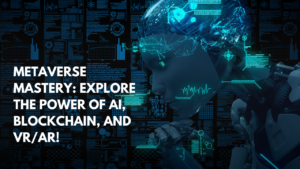Elevate Your Pressure Washing Business: The Ultimate Digital Marketing Guide...
Read MoreEmbarking on the Infinite: Unveiling the Metaverse - Part 1 of a Riveting Series

Table of Contents
Introduction
Step into the future as we embark on a riveting exploration of Metaverse technology — a groundbreaking amalgamation of virtual and augmented reality, advanced networking, and artificial intelligence. The Metaverse, once a speculative concept, has now blossomed into a technological marvel, reshaping the way we perceive and engage with the digital realm. In this journey, we unravel the intricacies of the core technologies propelling the Metaverse forward, unlocking the doors to immersive experiences, seamless connectivity, and limitless possibilities in this ever-expanding digital frontier. Join us on this technological odyssey as we peer into the heart of the Metaverse, where innovation meets imagination and the boundaries of reality are redefined.
What is Metaverse Technology?
Metaverse technology refers to a collective virtual shared space that merges aspects of augmented reality (AR), virtual reality (VR), and the internet. It enables users to interact with a computer-generated environment and other users in real time. Individuals can engage in various activities, socialize, and exchange information in a persistent, immersive, and interconnected digital universe characterized by the Metaverse. It often involves using blockchain technology to facilitate secure transactions and ownership of digital assets. Companies actively explore Metaverse development for gaming, social networking, education, and business applications. The concept envisions a seamless integration of physical and virtual realities, offering a new dimension for human interaction and digital experiences.
Why is the Metaverse important?
Metaverse technologies provide immersive and interactive experiences, enhancing engagement in ways traditional platforms cannot. Virtual reality (VR) and augmented reality (AR) enable users to feel present in digital environments, fostering a more profound connection. The Metaverse facilitates enhanced collaboration and social interaction. Virtual spaces allow users to communicate, work, and socialize in shared digital environments, transcending geographical constraints, which can revolutionize remote work, education, and social relationships.
The Metaverse offers new economic possibilities. Virtual assets, currencies, and marketplaces within these digital spaces create opportunities for entrepreneurship, trade, and job creation. Digital real estate, virtual goods, and services contribute to a new digital economy. Many Metaverse applications leverage blockchain technology for decentralization and security. It ensures ownership and authenticity of digital assets, prevents fraud, and establishes trust in transactions within the virtual space.
Metaverse technologies redefine e-commerce by providing immersive shopping experiences. Virtual storefronts, digital product trials, and personalized shopping in virtual environments can revolutionize how businesses engage with consumers. It has the potential to transform education and training. Simulations and virtual environments can provide realistic, hands-on learning experiences for various fields, from medicine to aviation, improving skill acquisition and retention.
Privacy and security become critical concerns as Metaverse collects vast user data. Ensuring robust safeguards, ethical data practices, and user consent mechanisms are essential to prevent misuse of personal information.
Evolution of Metaverse:
1. Emergence of Virtual Worlds:
The evolution of Metaverse technology traces its roots to the early days of the Internet when essential virtual worlds and online games began to emerge. These primitive virtual spaces allowed users to interact with each other and a digital environment, setting the foundation for a shared, immersive online space. As technology advanced, so did the complexity and capabilities of these virtual worlds, laying the groundwork for what would later become the Metaverse.
2. Integration of Advanced Technologies:
The evolution accelerated with the integration of advanced technologies such as virtual reality (VR), augmented reality (AR), artificial intelligence (AI), and blockchain. VR and AR technologies brought about immersive and interactive experiences, while AI-enhanced the intelligence and responsiveness of virtual environments. With the introduction of non-fungible tokens (NFTs), blockchain revolutionized ownership and transactions within the Metaverse, fostering virtual economies and digital asset ownership.
3. Interconnected Virtual Realms:
As the Metaverse evolved, a significant shift occurred towards creating interconnected virtual realms. Interoperability standards emerged, enabling users to seamlessly navigate and transfer assets across various virtual worlds and platforms. This interconnectedness laid the groundwork for a more unified and expansive Metaverse, where users could carry their digital identities and possessions across diverse virtual environments.
4. Rise of Decentralization and User-Centric Experiences:
In the latest phase of the Metaverse’s evolution, decentralization has become a key theme. Blockchain and decentralized technologies ensure transparency, security, and user ownership, empowering individuals within the Metaverse. User-centric experiences, driven by personalized AI interactions and immersive technologies, have taken center stage, emphasizing the importance of creating a dynamic, engaging, and inclusive virtual space. The ongoing evolution of the Metaverse continues to be shaped by advancements in technology, user demands, and the collaborative efforts of diverse industries.
Core technologies that define Metaverse
Several core technologies contribute to the definition and development of the Metaverse. These technologies work together to create immersive, interconnected digital experiences. Here are some key components:
Virtual Reality (VR) in the Metaverse:
VR immerses users in entirely digital environments, providing a sensory-rich experience. In the Metaverse, VR enables users to interact with a computer-generated world through specialized headsets, offering a sense of presence and depth. This technology is crucial for creating immersive virtual spaces facilitating virtual meetings, gaming, and exploration, where users feel physically present in the digital realm.
Augmented Reality (AR) in the Metaverse:
AR overlays digital content onto the real world, enhancing users’ perception of their physical environment. In the Metaverse, AR technologies use devices like glasses or smartphones to blend virtual elements seamlessly with the real world, which lets users interact with physical and digital characteristics simultaneously, fostering augmented experiences. AR in the Metaverse finds applications in navigation, information display, and interactive experiences that enhance the user’s understanding and engagement with the surrounding environment.
Spatial Computing in the Metaverse:
Spatial computing is a critical component of the Metaverse, seamlessly integrating the physical and virtual worlds. This technology understands and processes the spatial relationships between objects and users, enhancing interactions within immersive environments. Through computer vision, spatial mapping, and sensor fusion, spatial computing enables the realistic placement of virtual elements in physical space. Users can navigate, manipulate, and interact with digital content as if it exists in the real world. This technology is fundamental for creating a coherent and intuitive user experience in the Metaverse, fostering natural interactions and a sense of presence within the virtual environment.
Artificial Intelligence (AI) in the Metaverse:
AI plays a central role in the Metaverse by powering intelligent and adaptive features. AI enhances user experiences through advanced algorithms by personalizing virtual environments, predicting user behavior, and enabling lifelike interactions with virtual entities. Natural language processing (NLP) allows for realistic communication, while machine learning (ML) contributes to dynamic and responsive virtual characters. AI-driven analytics also enable the creation of personalized content and recommendations, enriching the diversity of experiences within the Metaverse. Overall, AI technologies in the Metaverse bring about heightened interactivity, responsiveness, and immersion, shaping a more intelligent and engaging virtual world.
Blockchain and NFTs in the Metaverse:
Blockchain technology forms the backbone of the Metaverse, providing a decentralized and secure foundation. It ensures transparent and tamper-resistant transactions, fostering trust in virtual economies. Non-Fungible Tokens (NFTs), a unique blockchain application, represent ownership of digital assets in the Metaverse. NFTs enable verifiable ownership and provenance of virtual items, such as digital art, virtual real estate, or in-game purchases. By leveraging smart contracts on blockchain, NFTs empower creators with automatic royalty payments and enable users to buy, sell, and trade digital assets with a transparent and immutable record. Integrating blockchain and NFTs promotes a vibrant and decentralized virtual economy within the Metaverse.
Edge Computing in the Metaverse:
Edge computing is pivotal in the Metaverse, minimizing latency and enhancing real-time interactions. By processing data closer to the user, at the network’s edge, instead of relying solely on centralized servers, edge computing reduces lag and ensures a smoother user experience. Edge computing facilitates faster data processing in the Metaverse, where responsiveness is crucial for applications like virtual gaming and live events. It enables quicker decision-making for interactive elements within virtual environments, contributing to a more immersive and seamless user journey. Overall, integrating edge computing in the Metaverse enhances performance, responsiveness, and the overall quality of user interactions in this dynamic digital space.
Conclusion
In conclusion, the Metaverse represents a groundbreaking fusion of technology and imagination, offering a glimpse into a future where digital and physical realities seamlessly intertwine. From its conceptual origins in science fiction to the current advancements in virtual reality, blockchain, and artificial intelligence, In the digital age, the Metaverse is poised to reshape how we interact, work, and socialize. As we delve deeper into the intricacies of this evolving landscape, the next series of blogs will explore specific aspects of the Metaverse, from technological innovations to societal implications, unraveling the layers of this transformative digital realm. Join us in the next installment as we continue our journey through the vast and dynamic landscape of the Metaverse.
The Rise of Voice Search: Optimizing Content for Smart Speakers
The Rise of Voice Search: Optimizing Content for Smart Speakers...
Read MoreMetaverse Mastery: Explore the Power of AI, Blockchain, and VR/AR!
Metaverse Mastery: Explore the Power of AI, Blockchain, and VR/AR! Table of...
Read MoreImmersive Horizons: Exploring Metaverse Technology’s User Experience and Challenges
Immersive Horizons: Exploring Metaverse Technology’s User Experience and Challenges Table...
Read More





